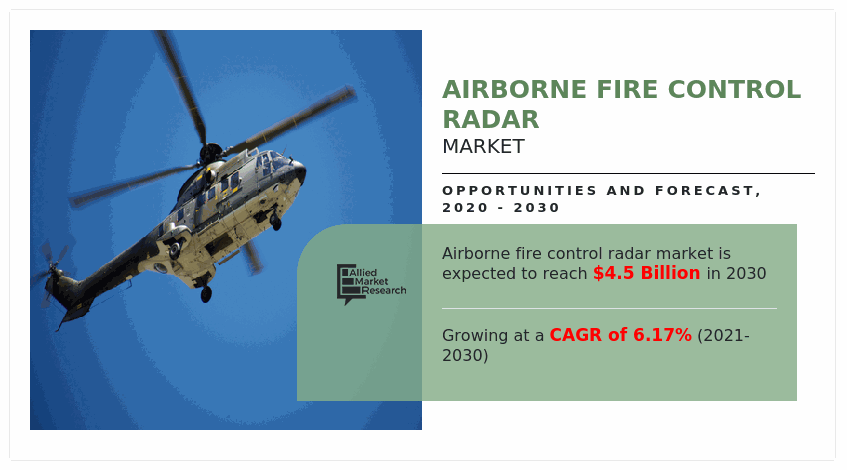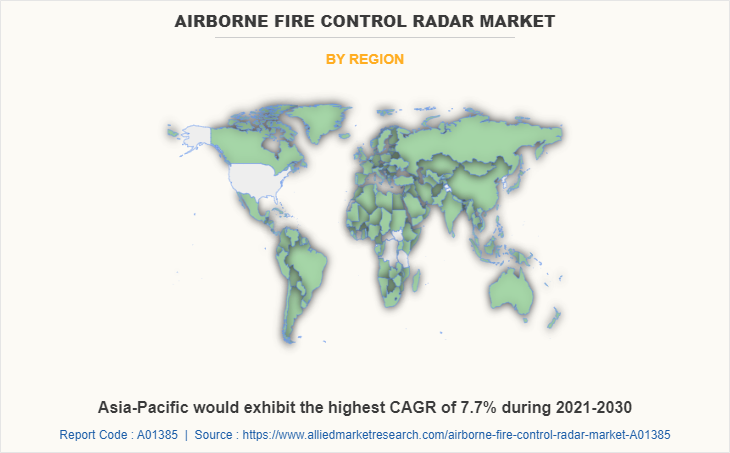Airborne Fire Control Radar Market Research, 2030
The global airborne fire control radar market size was valued at $2,499.30 million in 2020, and is projected to reach $4,455.09 million by 2030, growing at a CAGR of 6.17% from 2021 to 2030. A fire control radar is a radar that identifies the coordinates of a target and provides data, which is utilized to determine target trajectory and its continuous position. Airborne fire control radar detects the target, estimates the target range, range rate, azimuth angle & elevation angle for long detection ranges, high mission reliability, and multi-target tracking capabilities. These radars are developed for air-to-air, air to sea, and air to sea missions.

The growth of global airborne fire control radar market is driven by growth in usage of active electronically scanning array (AESA) technology, rise in accession of fighter jets to improve aerial strength, and surge in military expenditure in numerous countries. However, high maintenance cost is the factor that restrains the growth of the airborne fire control radar market. Furthermore, technological advancements and upsurge in demand from emerging economies to address territorial conflicts are the factors expected to offer growth opportunities during the forecast period.
By Frequency Band
Ku/K/Ka-Band is projected as the most lucrative segment
The market is segmented on the basis of frequency band, platform, application, and region. Based on frequency band, it is classified into X-band, L and S-band, and Ku/K/Ka-band. By platform, it is segmented into combat helicopters, fighter jets, and others. On the basis of application, the market is divided into air to sea, air to ground, and air to air. By region, the report is analyzed across North America, Europe, Asia-Pacific, and LAMEA.

Some leading companies profiled in the airborne fire control radar market report include BAE Systems Plc, Bharat Electronics Limited, Hensoldt AG, Israel Aerospace Industries, Leonardo S.P.A., Lockheed Martin Corporation, Northrop Grumman Corporation, Raytheon Technologies Corporation, SAAB AB, and Thales Group.
Growth in Usage of Active Electronically Scanning Array (AESA) Technology
Traditional radar with rotating antennas operating on fixed frequency were usually able to perform only one function and required separate units for other function such as surveillance and targeting. However, Active Electronically scanning array (AESA) technology based radars are capable of carrying out several functions simultaneously. In addition, AESA radar can produce radar pulses on different frequencies with interleaved pulse streams carrying out several functions simultaneously. This surge in usage of active electronically scanning array technology in radars is expected to drive the growth of airborne fire control radar market.
Rise in Accession of Fighter Jets to Improve Aerial Strength
Several countries continuously seek to upgrade their air force fleet and related equipment. However, in recent years, several countries are purchasing new aircrafts, equipped with latest technology to strengthen their air force. For instance, in July 2020, in India, Defense ministry approved a defense deal for procurements of MiG-29 jets for Indian Air Force and upgradation of 59 existing MiG-29 jets in IAF inventory from Russia. This rise in accession of fighter jets by numerous countries to improve aerial strength in their region is anticipated to drive the growth of the airborne fire control radar market.
Growth in Military Expenditures in Numerous Countries
Globally, military spending increased to almost $2 trillion in 2020 despite COVID-19 pandemic. The major countries that contribute to rise in military expenditure comprise U.S., China, Russia, India, Japan, and South Korea. Numerous countries have also increased their budget for military. For instance, Russia’s military expenditure increase by 2.5% in 2020 to reach $61.7 billion. Henceforth, growth in military expenditure in numerous countries is anticipated to drive the growth of the airborne fire control radar market.
Key Benefits For Stakeholders
This report provides a quantitative analysis of the market segments, current trends, estimations, and dynamics of the airborne fire control radar market analysis from 2020 to 2030 to identify the prevailing airborne fire control radar market opportunities.
The market research is offered along with information related to key drivers, restraints, and opportunities.
- Porter's five forces analysis highlights the potency of buyers and suppliers to enable stakeholders make profit-oriented business decisions and strengthen their supplier-buyer network.
- In-depth analysis of the airborne fire control radar market segmentation assists to determine the prevailing market opportunities.
- Major countries in each region are mapped according to their revenue contribution to the global market.
- Market player positioning facilitates benchmarking and provides a clear understanding of the present position of the market players.
- The report includes the analysis of the regional as well as global airborne fire control radar market trends, key players, market segments, application areas, and market growth strategies.
Airborne Fire Control Radar Market Report Highlights
| Aspects | Details |
| By Frequency Band |
|
| By Platform |
|
| By Application |
|
| By Region |
|
| Key Market Players | Hensoldt AG, Thales Group, Lockheed Martin Corporation, BAE Systems Plc, Raytheon Technologies Corporation, Israel Aerospace Industries, Northrop Grumman Corporation, Leonardo S.p.A., Saab AB, Bharat Electronics Limited |
Analyst Review
An increased focus on adoption of active electronically scanned array (AESA) technology in radar systems in aircrafts has been witnessed. This is due to the reason that AESA based radar transmits radio waves at different frequencies in multiple directions to offer longer range, detection of smaller targets, and resistance to jamming. It also provides numerous functions to be performed simultaneously unlike the traditional radar systems, which perform only one function & require separate units to perform other several functions such as surveillance and tracking.
Growth of the airborne fire control radar market is propelled by factors such as rise in usage of active electronically scanning array (AESA) technology in aircrafts and technological advancements in airborne fire control radar systems. Several developments have been carried out by key players operating in the airborne fire control radar industry. In December 2021, Bharat Electronics Limited developed airborne fire control radar under Make in India initiative, which is going to be equipped in Tejas light combat aircraft. Moreover, in September 2020, Lockheed Martin Corporation received contracts from armies of Morocco, Netherlands, UAE, and India to provide AH-64E Apache helicopter AN/APG-78 LONGBOW fire control radar, which can aid Apache helicopter in air to air, air to surface, & air to sea surveillance.
Rise in demand for airborne fire control radar from emerging economies, such as Asia-Pacific, coupled with increased procurement of fifth generation fighter jets in China, and growth in demand for combat helicopters & UAV from emerging economies such as India & China are expected to supplement the market growth. Collaborations and acquisitions are projected to enable the leading players to enhance their product portfolios and expand into different regions.
The global airborne fire control radar market is expected to reach $4,455.1 million in 2030
The upcoming trends in airborne fire control radar industry include growth in usage of active electronically scanning array (AESA) technology, and modernization of fighter jets
The leading companies in airborne fire control radar include BAE Systems Plc, Bharat Electronics Limited, Hensoldt AG, Israel Aerospace Industries, Leonardo S.P.A., Lockheed Martin Corporation, Northrop Grumman Corporation, Raytheon Technologies Corporation, SAAB, and Thales Group.
The adoption of airborne fire control radar market is expected to increase during the forecast period owing to greater usage of active electronically scanning array (AESA) technology, rise in accession of fighter jets to improve aerial strength, and urge in military expenditure in numerous countries.
A fire control radar identifies the coordinates of a target and provides data, which is utilized to determine target trajectory and its continuous position. Airborne fire control radar detects the target, estimates the target range, range rate, azimuth angle & elevation angle for long detection ranges, high mission reliability, and multi-target tracking capabilities.
Loading Table Of Content...



